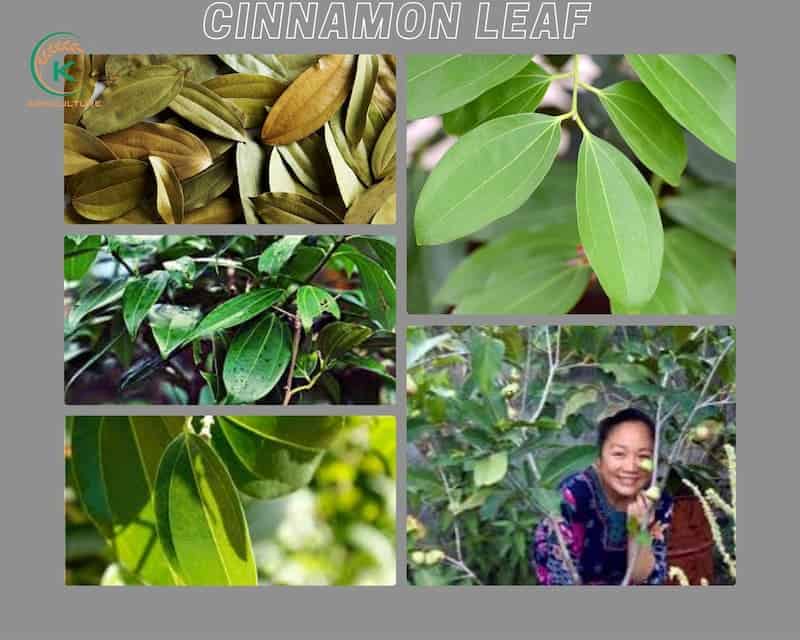Two common spices found in many different cuisines around the world are cinnamon leaf and bay leaf. These two spices are significantly distinct in terms of flavor, scent, and usage despite having names that sound similar. We’ll examine the main distinctions between cinnamon leaf and bay leaf in this blog post, as well as how to use each in recipes.
Contents
What is Cinnamon Leaf?
The cinnamon tree, a member of the laurel family, produces leaves that are used to make a cinnamon leaf, a spice. Originally from Sri Lanka and India, the cinnamon tree is currently grown in various tropical areas all over the world. There are a host of cinnamon leaves benefits. Cinnamon leaf is frequently used in South Asian and Middle Eastern cooking, where it is utilized to lend a warm, spicy flavor to curries, soups, and stews. Additionally, it is employed in baking, notably for desserts like cakes and cookies.

Cinnamon Leaf
The flavor of the cinnamon leaf is considerably different from the bark of the cinnamon tree and is sweet and spicy. It has a pleasant, woodsy scent that is frequently compared to nutmeg or cloves. Although cinnamon leaf can be found fresh and dried, a dried cinnamon leaf is the most popular type.
What is Bay Leaf?
The leaves of the Mediterranean native bay laurel tree are used to make the spice known as bay leaf. Bay leaf is frequently used in soups, stews, and sauces in European and Mediterranean cuisines to give them a delicate, earthy flavor. Additionally, it is employed in the making of bay leaf oil, pickling, and preserving.

Bay Leaf
A moderate, herbal flavor frequently described as being both little bitter and somewhat sweet characterizes bay leaf. It smells strong, pungently, much like eucalyptus or mint. Although bay leaf can be found both fresh and dried, dried bay leaf is the most popular type.
Top 4 Key Differences between Cinnamon Leaf and Bay Leaf
Quite often, even in desserts, Indian cuisines call for cinnamon leaves. They go by a variety of names as well; in some parts of India, they are referred to as “tej pat leaves,” and they are also referred to as “Indian bay leaves,” “Malabar leaves,” and “Malabathrum.” The reason for the last one is that bay leaves and cinnamon leaves both come from a species of laurel tree, yet neither is the exact same tree from which we obtain cinnamon bark. Here are four differences between cinnamon leaf and bay leaf.

Differences between Cinnamon Leaf and Bay Leaf
Flavor and Aroma
The flavor of the cinnamon leaf is considerably different from the bark of the cinnamon tree and is sweet and spicy. It has a pleasant, woodsy scent that is frequently compared to nutmeg or cloves.
On the other hand, bay leaf has a moderate, herbal taste that is frequently described as being a little bit bitter and a little bit sweet. It smells strong, pungently, much like eucalyptus or mint.
Culinary Uses
Cinnamon leaf is frequently used in South Asian and Middle Eastern cooking, where it is utilized to lend a warm, spicy flavor to curries, soups, and stews. Additionally, it is employed in baking, notably for desserts like cakes and cookies.
Bay leaf is frequently used in soups, stews, and sauces in European and Mediterranean cuisines to give them a delicate, earthy flavor. Additionally, it is employed in the making of bay leaf oil, pickling, and preserving.
Appearance
In terms of appearance, what is the difference between cinnamon leaf and bay leaf? A cinnamon leaf has a long, slender shape, a pointed tip, and a serrated edge. When it is new, it normally has a green tint, but when dried, it has a brown color.

Cinnamon Leaf vs Bay Leaf
The pointy tip of a bay leaf is elliptical in shape. Normally, it is a dark green tint when it is fresh, but when dried, it becomes a dark brown color.
Medicinal Uses
Cinnamon leaf and bay leaf are often incorporated into medicine. Cinnamon leaf is thought to provide a range of health advantages, such as the capacity to lower blood sugar levels, reduce inflammation, and ward off infections.
The bay leaf is also thought to help with digestion, ease stress and anxiety, and soothe sore throats, among other health advantages.
How to Use Cinnamon Leaf and Bay Leaf in Cooking
Two spices that are frequently used in cooking are bay leaf and cinnamon leaf. They both have unique flavors that can improve the flavor of a variety of foods. Here are several recipes that call for using bay leaf and cinnamon leaf:
Cinnamon Leaf
Similarly, bay leaf and cinnamon leaf are boiled in foods that have been cooked for a long time before being eaten. Cinnamon leaves, however, taste entirely different from bay leaves. They have a flavor similar to cinnamon and cloves with hints of citrus. It’s actually preferable to use a clove and a small piece of cinnamon instead of a conventional bay leaf if you don’t have any cinnamon leaves for a dish. There are various effective uses of cinnamon leaves.

Cinnamon leaf in cooking
- Making Tea and Other Drinks with Cinnamon Leaf: Tea and other drinks can be made with cinnamon leaf. Just a few leaves were added to boiling water, and steeped for a few minutes. Additionally, you can spice cocktails and other drinks using cinnamon leaves.
- Cakes, cookies, and pastries are some examples of sweet baked items where the cinnamon leaf is frequently utilized in baking. Just smash the leaves and include them in the dough or batter.
- Rice meals: To enhance flavor and scent in rice meals like pilafs and biryanis, the cinnamon leaf is frequently added. Simply sprinkle ground cinnamon leaf over the cooked rice or add a few leaves to the cooking water.
- Meat Dishes: Stews, curries, and roasts can all be flavored with cinnamon leaves. Simply stir a few leaves into the broth before cooking, or sprinkle ground cinnamon leaf over the meat.
Bay Leaf
- Bay leaf is frequently used to add flavor to soups and stews. Just add a few leaves to the liquid during cooking, then remove them before eating.
- To flavor sauces like marinara and béchamel, use a bay leaf. Just a few leaves to the sauce, then take them out just before serving.

Cooking with bay leaf
- Meat recipes: Beef stew and pot roast are two classic meat recipes that employ bay leaf as an ingredient. You can either sprinkle ground bay leaf over the meat before cooking or only add a few leaves to the boiling broth.
- Veggies: To enhance the flavor of vegetable dishes such as roasted potatoes and grilled veggies, bay leaf can be used. Before cooking the vegetables, simply smash a few leaves and sprinkle them on top.
Both cinnamon leaf and bay leaf can be used to flavor and add aroma to a number of foods. To create unique and fascinating flavor combinations, experiment with these spices in your cuisine.
Regardless of whether you are a fan of cinnamon leaf and bay leaf or simply interested in their health benefits, we hope that this post furnishes you with all the necessary information. If you have any questions, don’t hesitate to leave a comment. Our experts from K-Agriculture, which is one of the biggest factories in agriculture in Vietnam will help you with further explanation.





Please Post Your Comments & Reviews